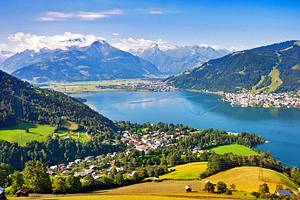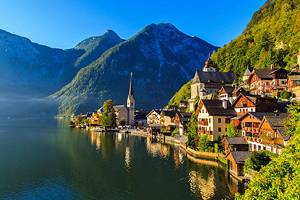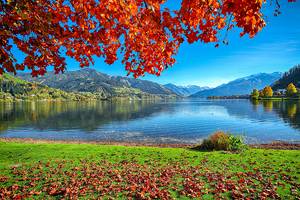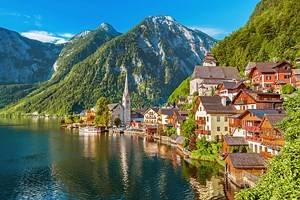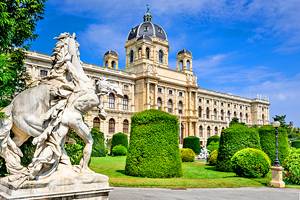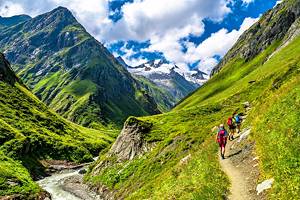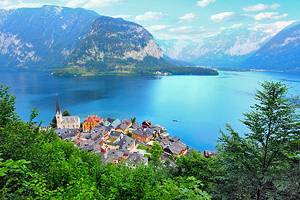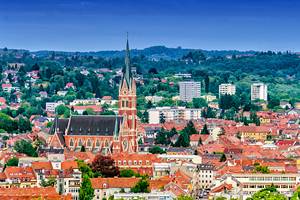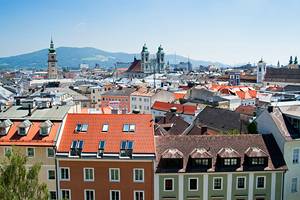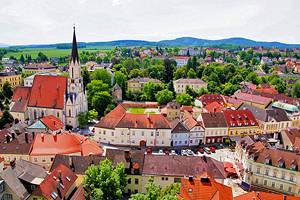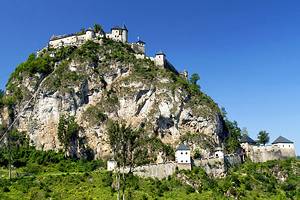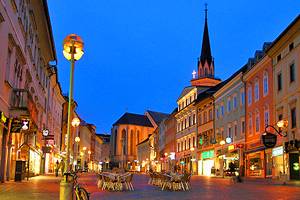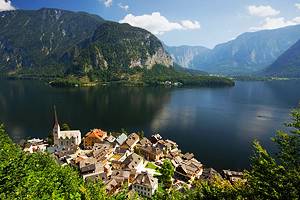Places to Visit in Austria
There is hardly a spot in Austria that isn't worth visiting, either for its rich history or its breathtaking scenery, but some stand out above the rest. Many of the best places to visit are popular tourist attractions that take a day or more to fully explore, like many of the grand Hapsburg palaces of Vienna and Salzburg or the Benedictine Abbey in Melk.
Likewise, old city neighborhoods full of stunning Baroque facades and historic landmarks can occupy tourists for days, providing endless photo-ops, as well as shopping and dining.
Outside of the bigger cities, Austria has several regions that are full of cultural attractions and outdoor activities. Winter travelers can challenge themselves on the ski trails of Austria's Alpine slopes, and those visiting in the summer can even find a mountain lake that feels like the Mediterranean. Any time of year, tourists can admire the idyllic pastoral landscape dotted with traditional farmhouses.
Plan your sightseeing itinerary in this beautiful country with our list of the best places to visit in Austria.
Vienna

The stunning city of Vienna is home to grand palaces, historic cathedrals, and over a hundred museums and art galleries. Located at the heart of the historic city, the 5.3-kilometer Ringstrasse was built during the 19th century to be the city's cultural hub. Tourists who are short on time can hop aboard the Vienna Ring Tram, which can be used for self-guided tours or to get from one museum to the next. Beautiful gardens and parks are laid out along the route.
Tourists will find a variety of architectural styles among the fine buildings, including several Neo-Renaissance-style landmarks, including the Natural History Museum (Naturhistorisches Museum), the Museum of Fine Arts, and the State Opera. Other styles represented include several New Gothic buildings (Votive Church, the Museum for Applied Art, and the Vienna Stock Exchange), Flemish Gothic (City Hall), and New Baroque (Burgtheater).
Other Ringstrasse attractions include the University of Vienna, the Parliament buildings, and the Imperial Hofburg Palace which is home to several of Vienna's major museums including the Natural History Museum, the Sisi Museum, and the Imperial Apartments. The complex is one of the world's largest palaces, consisting of 18 groups of buildings on 59 acres with a total of 2,600 rooms and over a dozen courtyards. It showcases a range of architectural styles, as it was expanded and modified by each Hapsburg ruler since 1275.

Another of Vienna's magnificent palaces is Schloss Belvedere (Belvedere Palace) which consists of two Baroque palaces simply referred to as Oberes (Upper) Belvedere and Unteres (Lower) Belvedere. Work began on the Lower Belvedere in 1700, and Prince Eugene used this palace as his personal residence.
The palace is also known for its collection of art, particularly medieval art and 19th- and 20th-century Austrian art found in the Österreichische Galerie Belvedere. The Upper Belvedere was completed in 1724, and it is here that the Austrian State Treaty was signed in 1955, marking Austria's independence.
The third major palace is Schloss Schönbrunn (Schönbrunn Palace), a beautiful estate featuring over 1,400 rooms and expansive manicured grounds. Construction began in the late 17th century, and it was completed in 1730, soon becoming the royal residence for the only female Hapsburg ruler, Maria Theresa. Visitors can tour 40 of the Baroque palace's rooms, including the Imperial Apartments in the West Wing. The surrounding park and gardens are equally stunning, featuring sculptures; fountains; and the dramatic Palm House, a Victorian-era greenhouse.

Vienna is home to an astounding number of museums, and among the city's best art museums are The Albertina, which has pieces by Pablo Picasso and Edvard Munch, and the Vienna Museum's collections, which house historic exhibits, as well as extensive art collections. Other top museums include the Technical Museum, the Kriminalmuseum (Crime Museum), and the Natural History Museum. For kids, there is a Kindermuseum (Children's Museum) located at Schönbrunn Palace, as well as the ZOOM Children's Museum.
Visitors who are interested in ecclesiastical attractions will not want to miss the stunning St. Stephen's Cathedral (Stephansdom), an impressive Gothic structure that was first erected during the 13th century. From the outside, tourists will be struck by the unique patterned roof and its 137-meter-tall spire, as well as the two Heidentürme (Heathen's Towers). The cathedral has numerous points of interest, including the Giant's Door, which is a fine example of Late Romanesque architecture, a 1640 High Altar made of black marble, three distinct chapels, and its 14th-century Catacombs.
Read More: Tourist Attractions & Things to Do in Vienna
Salzburg

Salzburg is packed with historic attractions, and is one of the best cities in Austria for tourists to get an in-depth cultural experience. The Getreidegasse in Salzburg is the heart of the Old City, home to fine historic buildings and shopping galore. Sitting on the left bank of the Salzach River, the Getreidegasse is a designated UNESCO World Heritage site.
Among Salzburg's top things to do is visiting Mozart's Birthplace, now a museum. With its unique through-houses and elaborately decorated Baroque facades, this district is ideal for photographers.
Another excellent place to visit for photos is Schloss Mirabell (Mirabell Palace), home to terraced Baroque gardens that were featured in The Sound of Music. The Schloss Hellbrunn (Hellbrunn Palace) was also featured in the iconic gazebo scene.
The Benedictine Abbey of St. Peter is another Old Town (Altstadt) attraction that cannot be missed, built in the late 7th century by St. Rupert. St. Peter's Church, adjacent to the abbey, is best known for its catacombs which were used during the filming of The Sound of Music.
Standing guard over the city of Salzburg from the top of Mönchsberg is the 11th-century fortress of Hohensalzburg. Hohensalzburg Castle can be reached by foot or via funicular, and the Prince's Apartments can be toured, as well as other areas of the ornately decorated Late Gothic palace.
Two excellent military-themed museums are also located here, including the Rainer Regiment Museum and the Fortress Museum, both of which contain examples of antique weapons and other artifacts.
Tirol Province

Tirol Province occupies most of the relatively narrow western end of Austria and follows the path of the valley's River Inn. The province borders Germany to the north, Italy to the South, and a small portion of Switzerland's northeastern border.
Its capital city of Innsbruck sits in this valley at the feet of the Nordkette mountain range and is a hub of historical, natural, and cultural attractions, as well as a convenient place to stay while exploring the Tirol region.
The area surrounding Innsbruck is home to some of Austria's most popular ski resorts and Alpine wonders like the Stubai Glacier, where visitors can explore tunnels and caves within the ancient ice. Two-time host to the Olympic Winter Games, Innsbruck's Patscherkofel ski area also offers a wide range of winter sports facilities.
In the summer, visitors can swim in the blue-green glacial waters of the surrounding lakes, with Lake Natters and Lake Lans conveniently close to Innsbruck. Hiking and biking is popular on the Alpine trails like Zirbenweg Trail on Patscherkofel. Rock climbers can safely practice at a climbing center in the nearby village of Igls.
Cultural attractions in the surrounding areas include the 16th-century Schloss Ambras (Ambras Palace) and Swarovski Kristallwelten, a museum dedicated to Swarovski crystals. In the town of Sölden, 007 ELEMENTS is an excellent museum for anyone fascinated by the James Bond films, with many a ski-chase scene filmed on the surrounding slopes.
Graz

The second-largest Austrian city, Graz has been an important trade city since the 12th century thanks to its position on the River Mur. The Old Town of Graz is home to several beautiful historic buildings and has been honored as a UNESCO World Heritage Site since 1999.
The Old Town is especially well known for its Baroque facades, and the 17th-century Haus am Luegg is one of the best examples, featuring intricate decorative stucco work and an arcaded first floor. Other notable buildings include the Renaissance-style Landhaus; the Rathaus (Town Hall); and the Franziskanerkirche (Franciscan Church), which has excellent examples of Late Gothic features. Schlossberg hill overlooks the old town, and visitors can visit its 16th-century Uhrturm (Clock Tower) via funicular.
Several museums are located in the Old Town district, including the Mohren Apotheke's Theriak Museum (Apothecary Museum) and the Stadtmuseum Graz (Graz Municipal Museum), as well as the Robert Stoltz Museum, which is dedicated to this 19th-century composer. Graz is also home to the world's largest historical armory museum, the Landeszeughaus (Styrian Armoury), which has displays of small arms, edged weapons, and armor made for both humans and their horses.
Rising to a height of 473 meters, the Schlossberg overlooks the Old Town of Graz, providing excellent views of the historic district. Once the site of fortifications, the 1561 Uhrturm (Clock Tower) is one of the only remaining structures, as well as the Glockenturm (Belfry), which features an eight-ton bell locally known as Liesl.
The Schlossberg is also home to family-friendly attractions, including a mini-railroad, an open-air theater, and a café with great views. This area can be accessed by a three-minute funicular ride or by foot in 20 minutes.
Read More: Tourist Attractions in Graz & Easy Day Trips
Historic Innsbruck

Among Innsbruck's most impressive historic attractions are the Hofburg, the former court palace, and Maria-Theresien Strasse, where you will find numerous 17th- and 18th-century buildings, including the Rathaus (Town Hall) and the Annasäule monument (St. Anne's Column). Throughout the Old Town district, tourists will find numerous examples of ornate Baroque architecture that features detailed stucco work and other embellishments.
While visiting Innsbruck, be sure to leave time for at least a ride on the Nordkettenbahn, a funicular which brings passengers from the center of town to Hungerberg for astounding views of the city and the mountains. There is also the option of continuing on to Seegrube, where you will find a restaurant and viewing area, as well as Karwendel, the country's largest nature park.
Bregenz

Situated in western Austria, Bregenz sits between Lake Constance (Bodensee) and the 1,064-meter Pfänder Mountain. Tourists should start their visit with a stroll along the Lake Promenade (Seepromenade) and a visit to the bustling harbor area, which is full of shopping, entertainment, and restaurants.
The impressive stage that hosts the Bregenz Festival (Bregenzer Festspiele) appears to float on the water. This venue seats 7,000 guests and presents an annual music festival that features opera and classical music, including prominent ensembles like the Vienna Symphony Orchestra.
A trip up the Pfänderbahn to the top of Pfänder Mountain is rewarded by spectacular views of the town, lake, and neighboring lakeside villages in Germany and Switzerland. While there, be sure to visit the mountain goats at the Alpine Wildlife Park, and see birds of prey at the Eagle Observatory.
More ambitious tourists can hike the mountain in about two hours, but you can enjoy the trail just as much if you ride up and then make your way back down to town by foot.
The Upper Town (Oberstadt) is home to old Roman fortifications, as well as several historic buildings. Top places to visit include the Old Town Hall (Alte Rathaus), built in 1622; the Deuringschlösschen palace, built in 1698; and several churches dating back as far as the 14th century. The Lower Town (Unterstadt) also has several historic attractions, like the late 17th-century New Town Hall (Rathaus) and several lovely churches, including the ornate Rococo St. Nepomuk Chapel.
Read More: Attractions & Things to Do in Bregenz
The Wachau Valley

Along the Danube River between Melk and Krems is the peaceful and dramatically beautiful Wachau Valley, full of small historic towns and hidden treasures. Due to its relative seclusion and idyllic natural surroundings, this was a popular place for monasteries during the Renaissance period, with more than 30 at one time.
One of the best-preserved of these is the Baroque Servite monastery of Maria Langegg, located in Aggsbach-Dorf, which is also home to the Wallfahrtsmuseum (Pilgrimage Museum).
For the same reasons, wealthy and royal families chose this valley for their summer residences. Located just five kilometers from Melk, Schloss Schallaburg is a beautiful Romanesque Renaissance palace featuring a Gothic chapel and stunning gardens.
The ruins of Medieval Aggstein Castle (Burgruine Aggstein) offer spectacular views from its cliff-top perch above the river, and from here, you can also see the town where the famous Paleolithic Venus of Willendorf was found.
Tourists should also seek out the town of Dürnstein, known for being one of Austria's most picturesque towns.
Melk Abbey

Melk Abbey is considered one of the finest monasteries in Europe, both for its architecture and contents. The building is a massive palatial structure that features multiple courtyards and a stunning Baroque church. Among its many embellishments, the Abbey church features a delicately carved high altar and pulpit and a painted ceiling.
Visitors will want to step out onto the terrace which faces the Wachau Valley below, an excellent spot for photographing the town below.
The monastery's true wonder is its library, with a main hall that is home to 16,000 volumes and an additional dozen rooms containing an additional 100,000 books. The main library hall is open to the public, featuring ceiling frescoes by Paul Troger and a spiral staircase that leads to the additional rooms. This stunning space was used by Umberto Eco for inspiration while writing The Name of the Rose.
While visiting, be sure to take some time to enjoy Melk's Old Town, located just below the Abbey. The Rathausplatz (Town Hall Square) is home to the Lebzelterhaus (Home for Itinerants), which features painted windows, as well as the Town Hall, which displays the city coat of arms. The Hauptplatz (Main Square) is another lovely spot that is close to historic landmarks like the Haus am Stein and the Altes Posthaus (Old Post Office).
- Read More: Tourist Attractions in Melk
Hallstätter See

The Hallstätter See is a lovely mountain lake in the Salzkammergut region of Austria. This serene glacial lake extends 8.5 kilometers long and is only two kilometers at its widest point, and the shore is dotted with idyllic villages.
A no-motor policy ensures that everyone's time on the lake is peaceful, and tourists can easily rent a rowboat or pedal boat to explore and take in the stunning mountain scenery.
One of the most beautiful villages on the lake is Hallstatt, located just over an hour from Salzburg. The town is named for the salt mine nearby, and its central Marktplatz (Market Square) is a good place to get a bite to eat and photograph the traditional homes.
Tourists can also visit Hallstatt Salt World, located nearby on Salzburg (Salt Mountain) and easily reached via funicular or cable car. Here, you can visit and learn about the 7,000-year-old mine, explore the old fortifications at Rudolfsturm (Rudolf's Tower), and brave the heights from atop the Skywalk viewing platform.
Linz

The capital city of Lower Austria, Linz sits on both sides of the Danube River, with its old town sights located primarily on the southern banks. The heart of the historic district is Landstrasse, home to picturesque Baroque buildings, as well as many fine boutiques and galleries. At the center is Hauptplatz, the beautiful market square and pedestrian area.
Perched on a hill adjacent to the old town is Linz Schloss (Linz Castle), a fortress that was first built in the ninth century and has been expanded and remodeled over the millennia. Today, it houses an excellent history museum (the Schlossmuseum), which has exhibits that include prehistoric and Roman artifacts, medieval arms and armor, and a variety of artwork.
Just outside the city center, tourists can find beautiful Botanic Gardens that feature native Alpine flowers, an enclosed rose garden, a cactus house, and exotic plants in a tropic house.
- Read More: Attractions in Linz & Easy Day Trips
Achensee

Achensee is one of the best lakes in Austria. It's known for its massive size, covering over 6.7 square kilometers and reaching a maximum depth of 133 meters, giving it the nickname "Sea of Tirol." The towns of Maurach and Pertisau are the best places to explore the lake from, offering plenty of lodgings to choose from.
Swimmers who don't mind cooler water enjoy this lake for its incredibly clear water, making this an excellent place for scuba diving. Kitesurfers and windsurfers will also find ideal conditions, thanks to thermal winds, and tourists can easily find boat rentals for a leisurely day on the water. Local tour operators also offer boat tours, and there is a steamer boat that circles the lake regularly, stopping at several towns.
The surrounding mountains and valleys are also lovely for exploring, with hiking, cycling, and mountain biking in the summer, and plenty of skiing in the winter.
Villach

This historic town in southern Austria began as a small Roman fortification and has become a prominent hub in the region, nestled by the Villacher and Julian Alps. Thanks to its Alpine neighbors, Villach is a popular place to stay while exploring the nearby ski areas at Afritz, Annenheim, Dreiländereck, St. Lambrecht, St. Blasen, and St. Urban.
Visitors will want to begin their time in Villach at the Hauptplatz (Main Square), home to several historic attractions, as well as many galleries, boutiques, and cafés. Points of interest include the Trinity Column at the center of the square and the parish church at the southern end. A short walk from the square is the 14th-century Parish Church of St. Jakob (Stadtpfarrkirche St. Jakob), which offers excellent views from its 95-meter tower.
Tourists can learn more about the city's history by visiting the Museum der Stadt Villach, which has exhibits featuring reproductions and artifacts from Villach's long history. Another significant historic site is the 14th-century Landskron Castle. Tourists can visit the ruins and enjoy beautiful views, as well as see demonstrations put on by the falconry center.
Animal lovers will also find some interesting attractions, including Affenberg Zoo and Rosegg Zoo. Affenberg Zoo is also known as Monkey Mountain, thanks to its population of over 150 Japanese macaques who live, play, and raise their families here. Rosseg Zoo specializes in exotic animals and includes a labyrinth, playground, and café.
Read More: Attractions & Things to Do in Villach
Lake Wörthersee

Located in the province of Carinthia, Lake Wörthersee (also called Lake Wörth) is the region's largest lake and one of the warmest of any Alpine lakes. During the warmest months, the clear glacial water can reach over 80 degrees Fahrenheit, while in the winter it is turned into a huge ice-skating rink.
It is a popular place for swimming and boating and has an almost Mediterranean atmosphere during the summer with its waterside restaurants and laid-back atmosphere.
Surrounded by mountains on all sides, visitors have even more recreational options. There are many hiking trails of various difficulty, as well as bike paths that are a great way to explore the shoreline and small lakeside communities. There are also several fitness courses, including the facilities used by the annual Kärnten Ironman Austria.
The provincial capital of Klagenfurt sits on the eastern end of the lake and is an excellent place to start your visit.
- Read More: Attractions in Klagenfurt & Easy Day Trips
St. Anton am Arlberg

This mountain in the Tyrolean Alps is home to one of Austria's best ski resorts, and also one of its most challenging. With 280 kilometers of terrain reaching as high as 2,811 meters, there are plenty of trails for intermediate and expert skiers to choose from.
The mountain is easily accessible from the village via lifts, and there is a bus available for less experienced skiers who would prefer to try out the easier trails on Zürs and Lech. Advanced skiers can also visit other Arlberg mountains via the "Run of Fame," an 85-kilometer trail that circles through these mountains as well as Warth.
Those who want to enjoy the mountain without having to face the slopes can take one of the sightseeing gondolas to the peak to admire the 360-degree views of the surrounding Alps, many of which reach over 3,000 meters in height. For a particularly breathtaking dining experience, take the Valluga Gondola Section II to the Valluga Restaurant for lunch or dinner.
Klagenfurt

Located in southern Austria near Lake Wörthersee, Klagenfurt is best known for its Old Town, which was founded in 1161. Originally a market town, Klagenfurt still hosts the Benedictine farmer's market, with local farmers from Austria, as well as Italy and Slovenia. It's a truly multicultural adventure.
Among the historic quarter's best attractions are its Renaissance courtyards and the stunning Klagenfurt Cathedral (Dom zu Klagenfurt), which houses the Gurk Diocesan Museum. This is also the best area to find a nice café to rest in after exploring the historic streets and buildings, or shopping in the boutiques.
Tourists will also want to explore Klagenfurt's old fortified walls, as well as its 16th-century moat and canal.
Other things to do in Klagenfurt include visiting the Lindwurmbrunnen (also known as Lindworm Fountain or Dragon Fountain) in Neur Platz, which was carved in 1590; the historic Landhaus (1574-90); and the Grosser Wappensaal (Great Emblem Hall), which was built in 1740.
Kitzbühel

Kitzbühel is one of Austria's most popular mountain sports destinations, full of skiing and snowboarding in the winter and rock climbing, mountain biking, and hiking in the summer. There is also a lovely Old Town (Innenstadt) filled with historic structures and cozy cafés.
Kitzbüheler Horn towers over the town at just shy of 2,000 meters and is home to the Alpenhaus restaurant and a few historic buildings. In nice weather, it can be scaled in around four hours via a path that starts in the middle of town, or brave tourists can drive to the top via a steep winding road. Any time of year, visitors can take the Pletzeralm to the top to enjoy the views.
This mountain, as well as nearby Hahnenkamm, Hornköpfli, and Steinbergkogel, all have excellent networks of ski trails, and in the winter, Kitzbühel is one of the top ski destinations in Austria.
Read More: Attractions & Things to Do in Kitzbühel
Voitsberg

Located a little over 40 kilometers from Graz is Voitsberg, best known as the home of the Lipizzaner thoroughbreds, the famed horses of Vienna's Spanish Riding School. Visitors can tour the actual farm, Piber Federal Stud, which includes a museum, stable tours, and even carriage rides pulled by the majestic horses.
The area is also home to some beautiful ruins that are fun to explore, like Neuleonrod Castle, where the forest is trying to reclaim the stone walls. A visit to Castle Krems (Burgruine Krems) rewards visitors with stunning views and lovely gardens.


